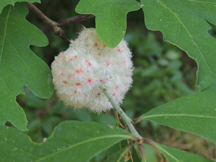I understand why people like to ride bikes fast, but I’m promoting the joys of slow cycling.
On a recent afternoon, I managed to spend several hours on my bike riding the Northern Rail Trail and the back roads of Andover and was dazzled by what I saw. I’m calling it Biology By Bike. In that brief period, I saw both new and familiar plants and animals that either helped solidify my identification skills or sent me to field guides and the Internet for help.
Ferns
The rail trail and roads are lined with ferns, a never-ending source of identification joys and frustrations. Two common varieties among those that I now know for sure are bracken fern and interrupted fern.
Probably the most widely-distributed fern genus (Pteridium) in the world, bracken has been used by humans for thatch and livestock bedding for centuries. The fronds are three or more feet high, and the blade is roughly triangular, divided into three parts, and nearly horizontal. Once you recognize this three-part fern, you’ll be amazed at how common it is.
Another cosmopolitan fern genus is Osmunda, which includes the interrupted fern. This fern gets its name from the gap in the middle of the blade left by the fertile portions after they fall off. Early in the summer you will see several short, dark-brown fertile segments until they wither and disappear, leaving a gap along the stipe.
Aquatic Plants
On my slow ride, I stopped often at wetlands and river edges to spy on turtles and hope for great blue herons. Each time I was distracted by the beautiful aquatic plants on view.
One of my favorites is pickerelweed (Pontederia cordata), with its lovely, long, heart-shaped leaves. By mid-summer a flower stem will develop, supporting a six-inch spike of violet-blue flower clusters that bloom in succession from the bottom up. Bring binoculars to study those blooms, and you’ll see the yellow spots that attract bees and butterflies.
Another aquatic perennial often found with pickerelweed is the yellow pond lily (Nuphar lutea), sometimes called bullhead lily. Its rhizome anchors the plant in the mud, sending up long stems. Attached to some stems are thick, floating, roughly heart-shaped leaves which can spread out over a meter. Separate stems support cup-shaped yellow flowers hiding numerous stamens and stigmas. Both pond lilies and pickerelweed are a major food source for muskrats.
There are several wetlands close enough to the rail trail for great viewing between Switch Road and Bridge Road, including Horseshoe Ponds.
Dragonflies
Each time I looked down at the rail trail when I stopped, I noticed a convention of dragonflies. Those I am still learning. The photo I took allowed me to navigate a friendly and helpful Web site to help with identification.
The site (imnh.isu.edu/digitalatlas/bio/insects/drgnfly/idkey/1.htm), which comes from the Idaho Museum of Natural History, presents pictures and asks Yes or No questions about wings and markings. It led me to a successful identification of my subject: a male chalk-fronted corporal (Ladona julia).
More research confirmed the gregarious nature of these skimmers and revealed that they are content near humans because of the mosquitoes we bring with us. Once you’ve seen one, you won’t forget it, because it has a chalky marks on the top of the thorax and at the base of the abdomen. The two stripes on the thorax are similar to a corporal’s uniform stripes.

Woolly Oak Gall
The highlight of my slow ride was a glimpse out of the corner of my eye of what appeared to be balls of cotton candy stuck in a low tree along Agony Hill Road. As I approached, I noticed light pink bits studding the surface. Even closer, I saw that the golf ball-size spheres were impaled on the stems of young white oak leaves.
Having no clue to what I was seeing, I snipped one branch and brought it home. Yes, dear reader, I Googled something like “cotton candy balls on oak leaves,” and after scrolling past Amazon’s candy options I found Web sites devoted to the Woolly Oak Gall.
A female gall wasp lays eggs, and the gall develops around them to protect the eggs and provide hatching larvae with nutrition from its tissue. There are about 800 species of gall wasps in the US, and the host plants and galls vary widely, although oak trees are host to a majority of the species. Had I been riding my bike fast, I never would have seen such a sight!
Please send your comments, photos, and questions to AndoverNaturally@nullgmail.com.